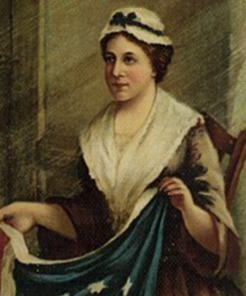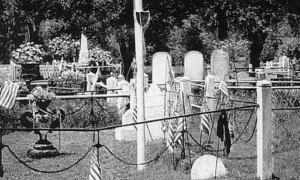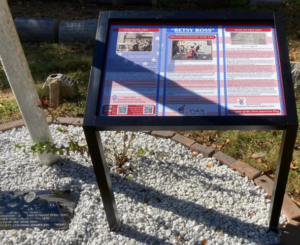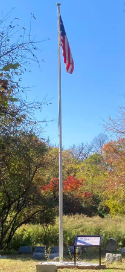Title: Seamstress, flag maker
Birthdate: January 1, 1752
Death Date: January 30, 1836
Plot Location: Section 51, Lot 17

It’s well known that Betsy Ross sewed flags. The claim that she made the first American flag is doubted by most historians, a legend that was popular as part of the nation’s centennial in 1876. It’s also well known that her remains were brought to Mount Moriah. The claim that the remains were removed in 1975 is also doubted by many, but it was a move that was popular as part of the nation’s bicentennial in 1976.
Whether her remains were here for nearly 120 years or are still here, her story is worth telling as a notable example of an early American entrepreneur. Her name has a permanent place in school textbooks as an example of the contribution of women to our nation’s history.
Early Life & Marriage
Betsy Griscom was the eighth of 17 children born to a Quaker family in Gloucester City, New Jersey, just south of Camden. When she was three years old the Griscoms moved to Philadelphia where the children attended Friends schools. She became an apprentice to an upholsterer, and that’s where she met fellow apprentice John Ross. They eloped on November 4, 1773 to have a quick wedding at a tavern. Because John was Anglican, the son of an Episcopal rector, Betsy was disowned by her family and the Society of Friends.
Along with starting their marriage, they started their own upholstery business. John joined the Pennsylvania Provincial Militia, but two years later he died, either from a gunpowder explosion or illness, leaving Betsy to run the business by herself.
It is well documented that she and several other seamstresses were commissioned to sew flags for the Pennsylvania Navy Board during the Revolutionary War. She made blankets, tents, and cloth cartridges for musket balls, even while the British occupied the city, although she could have been executed for treason if she was caught.
Betsy married a sailor, Joseph Ashburn, on June 15, 1777. They had two daughters, although one died as an infant. Then Joseph was captured and held in a British prison, so Betsy was alone again, working and raising her daughter. She learned of Joseph’s death in 1782 from a fellow prisoner who had been released. His name was John Claypoole, a man who had grown up with her in the Quaker community.
That meeting eventually led to their marriage in 1783. One of their five daughters died in infancy but the other four (plus her daughter with Joseph Ashburn) learned to be seamstresses. The Claypoole ladies continued for the next several decades making flags, ensigns, and banners for a wide variety of government and commercial customers.
Later Life & Burial
John helped his wife in the upholstery business and then worked at the U.S. Customs House. He died in 1817 after a long disability, but she continued to sew with her daughters and granddaughters for another ten years. Her eldest daughter, Clarissa Claypoole Wilson, took over her business when she could no longer work.
Betsy died in 1836 and was buried with John in the Free Quaker Burial Grounds on North 5th Street. The city purchased the property 20 years later, so the daughters probably paid to have their parents moved to Mount Moriah Cemetery, which had just opened in 1855. Their mother wasn’t famous at that point, but decades later the Claypoole plot certainly helped boost the cemetery’s image.
None of their children were buried at Mount Moriah, but a granddaughter and some great-grandchildren were. Clarissa’s daughter, Susan Claypoole Wilson Sellers, joined Betsy here in 1868. Then three children of Clarissa’s only son were buried in the family plot within seven years of each other. They were  Clarissa Wilson (1838-1922), Sarah Wilson (1840-1921), and Jacob Wilson (1852-1928).
Clarissa Wilson (1838-1922), Sarah Wilson (1840-1921), and Jacob Wilson (1852-1928).
In 1923 the Patriotic Order, Sons of America placed a granite marker near a flagpole that was erected in 1894 by the Sons of Veterans of the USA (today known as Sons of Union Veterans of the Civil War). This photograph is from that decade.
The Legend
What started the legend about sewing the first American flag was a paper presented by a grandson to the Historical Society of Pennsylvania in 1870. He admitted to lack of evidence, relying on sworn statements of family members and their recollections. There were other seamstresses of that era that also made the same claim, without proof. Of course there is no evidence that she wasn’t the first flag maker. Records show she had previous business dealings with George Washington. She received a commission to make bed curtains for his home in Mount Vernon.
Her grandson’s story got published in Harper’s Monthly in 1873 and the timing couldn’t have been better with the country’s 100th birthday just around the corner. Flying the nation’s flag became more popular than ever after the recent war. In addition, 15 percent of the labor force in 1870 was female, thanks to industrialization, so circulating the story of a successful woman in the business world was inspiring.
The Location
Talk of moving the Claypoole graves to Arch Street had begun in the 1960s. Mount Moriah’s image was being tarnished by the local neighborhood’s skyrocketing poverty and crime rate, including the theft of the flag and gravestone. The lack of cemetery security and the area’s reputation created a dangerous environment for visitors. With help from civic leaders, her descendants won a court order in 1975 to exhume the remains as the city prepared for the country’s 200th birthday.
An anthropologist was hired to supervise the project but the initial dig found nothing. Trying again a few feet away, the workers found a coffin with male bones. The next day they went farther still and found a male leg bone (femur) and a female skull fragment and decided it was a match. But from which female?
The only way to know for sure would be a DNA analysis, which wasn’t available in 1975. Removing remains is an inexact science, so it’s likely that the rest of their remains, if not all, are still in the ground. It should also be remembered that the bones of four relatives were in that plot: Susan Sellers, Clarissa Wilson, Sarah Wilson, and Jacob Wilson.
 Nearly a half-century later, several organizations thought it appropriate to commemorate the second true burial of the Claypooles. In 2022 an in-ground plaque was installed around the Betsy Ross flagpole by the Pennsylvania State Society, Colonial Dames of the 17th Century. Joining them in creating this storyboard were the Pennsylvania State Society, Daughters of the American Revolution; the Pennsylvania State Society, Children of the American Revolution; and the Pennsylvania State Society, United States Daughters of 1812.
Nearly a half-century later, several organizations thought it appropriate to commemorate the second true burial of the Claypooles. In 2022 an in-ground plaque was installed around the Betsy Ross flagpole by the Pennsylvania State Society, Colonial Dames of the 17th Century. Joining them in creating this storyboard were the Pennsylvania State Society, Daughters of the American Revolution; the Pennsylvania State Society, Children of the American Revolution; and the Pennsylvania State Society, United States Daughters of 1812. 
Regardless of her legend and her location, the legacy of Betsy Ross will be honored at Mount Moriah as a brave patriot, business owner, role model, and folk hero forever sewn into the fabric of American history.

Support the Friends of Mount Moriah
Help us in our mission to restore and maintain the beautiful Mount Moriah Cemetery by donating to our cause or volunteering at one of our clean-up events.

